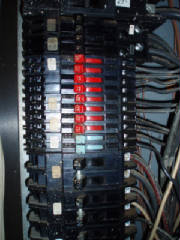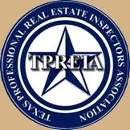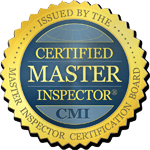Professional Home Inspections Tyler and Longview and the surrounding East Texas area.
Providing Home Inspections in Longview and Home Inspections in Tyler and the surrounding East Texas area with Full-Service Property Inspections

ALUMINUM WIRING
Aluminum wiring, used in some homes from the mid 1960's to the early 1970's, is a potential fire hazard. How safe is aluminum wiring? According to the U.S. Consumer Product Safety Commission, fires and even deaths have been reported to have been caused by this hazard. Problems due to expansion, or more likely micro-fretting and arcing at the connectors, can cause overheating at connections between the wire and devices (switches and outlets) or at splices. The connections can become hot enough to start a fire without ever tripping a circuit breaker!
CPSC research shows that "homes wired with aluminum wire manufactured before 1972 are 55 times more likely to have one or more connections reach "Fire Hazard Conditions" than are homes wired with copper. "Post-1972" aluminum wire is also a concern. Introduction of the aluminum wire "alloys" in 1972 time frame did not solve most of the connection failure problems. Aluminum wiring is still permitted and used for certain applications, including residential service entrance wiring and single-purpose higher amperage circuits such as 240V air conditioning or electric range circuits. The fire risk from single purpose circuits is much less than for branch circuits. But it's not necessarily because of a "new alloy" as some folks assert. It's because there are enormously fewer connections (four or six rather than 30 or 40 per circuit) and thus statistically a smaller chance of a connection failure. These connections do still burn up, as indicated by field reports.
This excerpt was obtained from Dan Friedman's web site "The Home Inspection and Construction Web Site". For more information click on to the following link: Aluminum Wiring Hazards
FEDERAL PACIFIC ELECTRIC PANELS
The central safety defect in FPE Stab-Lok(R) electrical equipment is that FPE Stab-Lok(R) circuit breakers fail to trip under overload or short-circuit conditions, at a failure rate much higher than comparable equipment made by other producers. When an overload or short circuit occurs in an electrical device (an electric clothes dryer for instance), the circuit supplying electricity to the device is supposed to be interrupted, electrical power cut off, by either a fuse or a circuit breaker. This interruption of electrical power is intended to minimize the resulting fire hazard of electrical overloads or short circuits.
Note – This excerpt was obtained from Dan Friedman's web site "The Home Inspection and Construction Web Site". For more information click on to the following link: Fire Hazards in Federal Pacific Electric Panels
ZINSCO ELECTRICAL PANELS
Where Zinsco electrical panels and Zinsco circuit breakers are in use, arcing, contact-point burn, and even circuit breaker case blow-out have been observed in the field. A principal Zinsco circuit breaker (or Sylvania circuit breaker for those Sylvania panels using the Zinsco product) point of failure appears to be at the point of contact where the circuit breaker contacts clip onto the electrical panel bus, combined with the use of an aluminum electrical panel bus. In addition to advice on identifying Zinsco panels, inspecting Zinsco electrical panels, and repair/replacement advice, we provide field photographs of circuit breaker failures: overheating, burnups, failures to trip, over current protection failure. This document includes field reports of failures and additional anecdotal evidence. As a not-for-profit activity, we have been collecting information and field failure reports for Zinsco/Sylvania electrical components since 1996 in an effort to develop credible failure-rate information which is then shared with the U.S. CPSC and with other electrical failure researchers and educators.
Note - This excerpt was obtained from Dan Friedman's web site "The Home Inspection and Construction Web Site". For more information click on to the following link: Fire Hazards in Zinsco Electric Panels
LEAD IN DRINKING WATER
Although water supplied from your water treatment plant may be free from lead/copper*, contamination from your piping system may cause lead/copper to dissolve (leach) into your water supply if: * You have a lead service line connecting your home to the water main in the street; and/or * Your home has lead water supply pipes; and/or * You have lead containing soldered joints in your copper supply pipes (installed from 1983-86); and/or * You have plumbing fixtures containing lead. * In rare cases some lead leaching may take place from piping in the street if it is a low flow area, i.e.; dead end streets.
ASBESTOS
Asbestos is a mineral fiber that can be positively identified only with a special type of microscope. There are several types of asbestos fibers. In the past, asbestos was added to many products to strengthen them and provide fire resistance and heat insulation. If disturbed, asbestos material may release asbestos fibers which can be inhaled into the lungs. Asbestos material that crumbles easily if handled or which has been scraped, sawed, or sanded into a powder is more likely to create a health hazard. Breathing high levels of asbestos fibers can lead to an increased risk of lung cancer, mesothelioma (cancer of lining of chest and abdominal cavity), and asbestosis (lungs scarred with the tissue). Houses built between 1930 and 1950 may have asbestos insulation. Most of today’s products do not contain asbestos. If asbestos material is more than slightly damaged or you plan changes that might disturb it, you require a professional for repair and removal. Before home remodeling, find out if asbestos is present.
LEAD PAINT
Since lead paint was banned in 1978, and since lead was a very common additive in paints (for whiteness and flexibility), it's a reasonable guess that any older home built before (or perhaps slightly after) 1978 that has painted surfaces has some lead paint present -- unless all of the old paint was removed. Painting over lead-containing painted surfaces is not a "fix" as lead can leach through new coatings or be released during renovations. According to the Brody article [Ref. 4] the following statistics apply to lead based paint in homes:
- Homes built before 1940 – lead paint is present in about two thirds of these buildings
- Homes built between 1940 and 1960 – lead paint is present in about half of these homes
- Homes built between 1960 and 1978 – lead paint is present in a smaller number
- OPINION – “Although lead-based paint was no longer sold that does not mean that someone may not have had older lead-based paint and used it after 1978. So don't rule out the possibility of lead in paint in buildings painted at least for a few years after 1978.”
Note - These excerpts were obtained from Dan Friedman's web site "The Home Inspection and Construction Web Site”.
MOLD
Mold (fungi) is present everywhere, indoors and outdoors. There are more than 100,000 species of mold, at least 1,000 of which are common in America. Species of Cladosporium, Penicillium, and Aspergillus are some of the most commonly found species. Mold most likely grows in bathrooms, basements, and anywhere else where there is dampness or water. Many types of mold routinely encountered aren’t hazardous to healthy individuals. Too much exposure to mold may cause a worsening of such conditions as asthma, hay fever, or other allergies. Fevers and breathing problems in a vulnerable individual are possible but unusual. When moldy material becomes damaged or disturbed, spores, which are reproductive bodies similar to seeds, can be released into the air. Exposure can occur if people inhale the spores, directly handle moldy material, or accidentally ingest the spores. Since all molds need water to grow, mold can grow almost anywhere where there is high humidity, dampness, or water damage. Most often molds are confined to areas near the water source. Removing the source of moisture through repairs or dehumidification is crucial in preventing mold growth. Correcting underlying water damage and cleaning the affected area is the best way to treat mold. If mold contamination is extensive, a professional abatement company may be needed.
If there has been a lot of water damage, and/or mold growth covers more than 10 square feet, consult the EPA's Mold Remediation in Schools and Commercial Buildings. Although focused on schools and commercial buildings, this document is applicable to other building types.
If you choose to hire a contractor (or other professional service provider) to do the cleanup, make sure the contractor has experience cleaning up mold. Check references and ask the contractor to follow the recommendations in EPA's Mold Remediation in Schools and Commercial Buildings, or the guidelines of the American Conference of Governmental Industrial Hygienists.
If you suspect that the heating/ventilation/air conditioning (HVAC) system may be contaminated with mold, consult the EPA's Should You Have the Air Ducts in Your Home Cleaned? before taking further action. Do not run the HVAC system if you know or suspect that it is contaminated with mold - it could spread mold throughout your home.
Note - Excerpted from the New York City Department of Health & Mental Hygiene, Environmental & Occupational Disease Epidemiology: “Facts About Mold”.
WOOD-DESTROYING ORGANISMS/INSECTS
Termites, which play a positive role in recycling wood and plant material, become a problem when they consume structural lumber. Every year thousands of U.S. housing units require termite treatment. These pests cause serious damage to wooden structures and posts and can also attack stored food, household furniture, and books. Successful termite management requires special skills, including a working knowledge of building construction and an understanding of termite biology and identification. In most cases, it is advisable to hire a professional pest control company for the inspection and control problem.
Wood-boring beetle larvae feed on wood and wood products. Adults of some species bore holes into plaster, plastic, and soft metals. Many species cause problems when emerging from wood in newly constructed buildings because they leave small circular or oval exit holes in the wood. To avoid these problems, infested wood must be kiln-fried before being used for lumber. The species Deathwatch Beetles is primarily found in soft woods (girder, beams, foundation timbers, some types of furniture, with some species attacking books). False Powderpost female beetles bore a tunnel, or egg gallery, into wood or other materials, then deposit eggs in pores or cracks within the tunnel. Adults of some species bore through such soft metal as lead and silver, as well as plaster and other non-wood materials. Affected structural wood should be removed and replaced whenever possible.
Wood Wasps and Horntails. Wood wasp damage in buildings is likely to be more cosmetic than structurally weakening. Emerging wood wasps can chew through any substance: wallboard or plaster walls, hardwood floors, carpeting, linoleum, non-ceramic floor tiles, and other interior surfaces.
Carpenter Ants. Several species can damage wood in building and other structures. Though ants don’t eat wood, they bore into it to make their nests, sometimes causing serious structural damage. Also, they nest in hollow doors, cracks and crevices, furniture, wall voids, and termite galleries. New building infestation occurs when land-cleaning in the area disturbs existing native colonies.
Excerpts from University of California Agriculture & Natural Resources, UCIPMOnline, “Statewide Pest Management Program”.
Proudly performing home inspections and commercial inspections in East Texas for over 33 years. Those areas are but not limited to: Home Inspections in Alba, Home Inspections in Arp, Home Inspections in Atlanta, Home Inspections in Avinger, Home Inspections in Big Sandy, Home Inspections in Blodgett, Home Inspections in Bogata, Home Inspections in Bullard, Home Inspections in Carthage, Home Inspections in Chandler, Home Inspections in Cypress Springs, Home Inspections in Daingerfield, Home Inspections in Diana, Home Inspections in Flint, Home Inspections in Frankston, Home Inspections in Gilmer, Home Inspections in Gladewater, Home Inspections in Hallsville, Home Inspections in Harleton, Home Inspections in Hawkins, Home Inspections in Hide-A-Way Lake, Home Inspections in Holly Lake, Home Inspections in Hughes Springs, Home Inspections in Jefferson, Home Inspections in Kilgore, Home Inspections in Lake Fork, Home Inspections in Lindale, Home Inspections in Linden, Home Inspections in Lone Star, Home Inspections in Longview, Home Inspections in Marshall, Home Inspections in Maud, Home Inspections in Mineola, Home Inspections in Mt. Vernon, Home Inspections in Mt. Pleasant, Home Inspections in Naples, Home Inspections in New Boston, Home Inspections in New Hope, Home Inspections in Omaha, Home Inspections in Ore City, Home Inspections in Overton, Home Inspections in Queen City, Home Inspections in Quitman, Home Inspections in Paris, Home Inspections in Pittsburg, Home Inspections in Scroggins, Home Inspections in Springhill, Home Inspections in Sulphur Springs, Home Inspections in Talco, Home Inspections in Texarkana, Home Inspections in Troup, Home Inspections in Tyler, Home Inspections in Winnsboro, Home Inspections in Winona, Home Inspections in Whitehouse, Home Inspections in White Oak, Home Inspections in Winfield, Home Inspections in Yantis.
NOTICE TO CONSUMERS AND SERVICE RECIPIENTS
A recovery fund is available for aggrieved persons
through the Texas Real Estate Commission
P.O. Box 12188, Austin, TX 788711-2188
(512) 936-3000
http://www.trec.state.tx.us/





